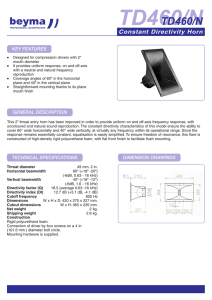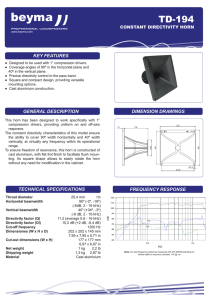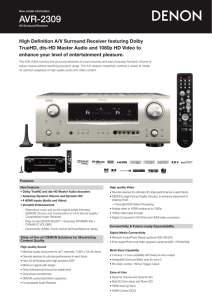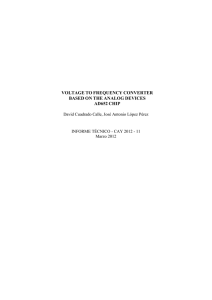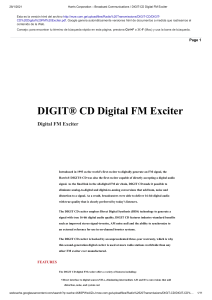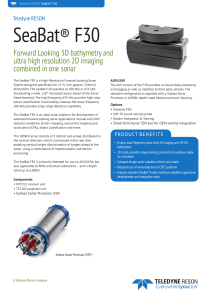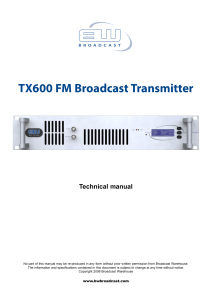BRIC-Link point-to-point IP audio conversion
Anuncio
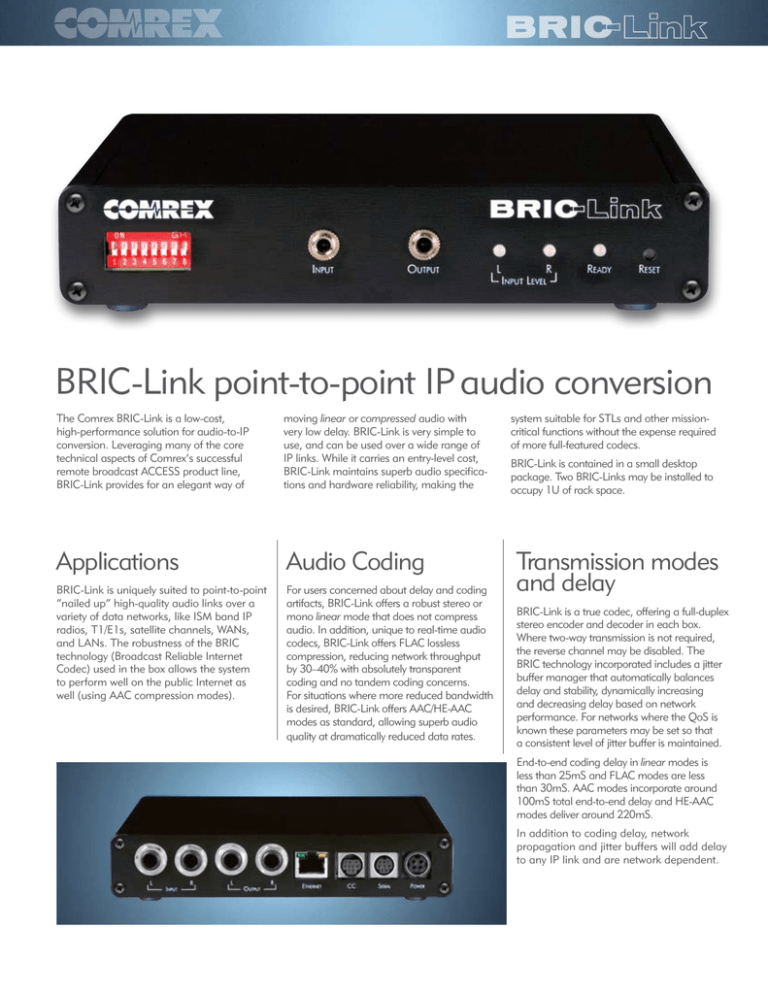
BRIC-Link point-to-point IP audio conversion The Comrex BRIC-Link is a low-cost, high-performance solution for audio-to-IP conversion. Leveraging many of the core technical aspects of Comrex’s successful remote broadcast ACCESS product line, BRIC-Link provides for an elegant way of moving linear or compressed audio with very low delay. BRIC-Link is very simple to use, and can be used over a wide range of IP links. While it carries an entry-level cost, BRIC-Link maintains superb audio specifications and hardware reliability, making the Applications Audio Coding BRIC-Link is uniquely suited to point-to-point “nailed up” high-quality audio links over a variety of data networks, like ISM band IP radios, T1/E1s, satellite channels, WANs, and LANs. The robustness of the BRIC technology (Broadcast Reliable Internet Codec) used in the box allows the system to perform well on the public Internet as well (using AAC compression modes). For users concerned about delay and coding artifacts, BRIC-Link offers a robust stereo or mono linear mode that does not compress audio. In addition, unique to real-time audio codecs, BRIC-Link offers FLAC lossless compression, reducing network throughput by 30–40% with absolutely transparent coding and no tandem coding concerns. For situations where more reduced bandwidth is desired, BRIC-Link offers AAC/HE-AAC modes as standard, allowing superb audio quality at dramatically reduced data rates. system suitable for STLs and other missioncritical functions without the expense required of more full-featured codecs. BRIC-Link is contained in a small desktop package. Two BRIC-Links may be installed to occupy 1U of rack space. Transmission modes and delay BRIC-Link is a true codec, offering a full-duplex stereo encoder and decoder in each box. Where two-way transmission is not required, the reverse channel may be disabled. The BRIC technology incorporated includes a jitter buffer manager that automatically balances delay and stability, dynamically increasing and decreasing delay based on network performance. For networks where the QoS is known these parameters may be set so that a consistent level of jitter buffer is maintained. End-to-end coding delay in linear modes is less than 25mS and FLAC modes are less than 30mS. AAC modes incorporate around 100mS total end-to-end delay and HE-AAC modes deliver around 220mS. In addition to coding delay, network propagation and jitter buffers will add delay to any IP link and are network dependent. Connections and indicators About the BRIC-Link Coding Algorithms: BRIC-Link offers balanced, professional level analog I/O on ¼" TRS connectors. Alternately, the Left I/O connectors may be switched to AES3 digital audio format. Consumer level, 3.5 mm unbalanced I/O is also available. Linear— BRIC-Link’s linear mode digitizes audio to 16 bit samples. It does not compress the audio further, but packetizes a frame of audio samples and transfers them across the network uncorrupted. Analog audio is sampled at 48 kHz, proving 22 kHz frequency response. Network connection is via 10/100 BaseT Ethernet jack. Contact Closure and Ancillary data are delivered on Mini-DIN style jacks. Audio level is displayed on the front panel via L & R tri-color LEDs. These LEDs may be configured to display send or receive level. A status LED on the front panel displays connection status as well as Ethernet status. User Interface BRIC-Link acts as a web server, delivering an intuitive user interface web page. The page displays connection status, and allows the user to configure profiles for various connections, as well as point-and-click connection commands. Extensive network diagnostics are available via the statistics section, and audio level meters are available for remote monitoring of levels in and out. Initial IP configuration is managed via a Windows-based setup utility to be run on a computer located on the same LAN. The utility also functions as an upgrade utility, allowing flash upgrades from the Comrex website to be applied to the hardware. Additional Features BRIC-Link provides for four end-to-end contact closures to be delivered along with the audio stream in each direction. Alternately, the contact closure inputs may be configured to initiate connections. An ancillary data stream is available via RS232 along with the audio stream. In AAC modes, the system is capable of sending up to 3 one-way encode streams to separate decoders (requiring additional bandwidth). In addition, BRIC-Link supports IP Multicast on capable networks. If AES3 Input/Output is used, BRIC-Link can utilize 44.1 kHz and 32 kHz sampled audio. As shown in Table 1, this can conserve network bandwidth (and reduce frequency response slightly). FLAC— BRIC-Link offers the FLAC (Free Lossless Audio Compression) algorithm for those who wish to conserve bandwidth without sacrificing audio quality. Since FLAC is lossless (the exact PCM word applied to the encoder is extracted from the decoder) there are no concerns about artifacts or immunity to further coding in the link. FLAC utilizes a variable output encoder, and data rate will rise and fall based on the ability of the encoder to compress a particular frame of audio. For example, during complete silence FLAC outputs less than 1/10th the data of linear PCM, while encoding full-spectrum, full scale white noise results in a data rate slightly higher than PCM. On average audio, FLAC will typically remove 30-35% of the network data when compared to linear. Algorithm Linear 48 kHz Mono Linear 48 kHz Stereo Linear 44.1 kHz Mono* Linear 44.1 kHz Stereo* Linear 32 kHz Mono* Linear 32 kHz Stereo* FLAC 48 kHz Mono FLAC 48 kHz Stereo FLAC 44.1 kHz Mono* FLAC 44.1 kHz Stereo* FLAC 32 kHz Mono* FLAC 32 kHz Stereo* AAC Mono AAC Stereo HE-AAC Mono HE-AAC Stereo HE-AAC Stereo v2 FLAC encodes analog audio at 48 kHz with 16 bit resolution. If AES3 In/Out is used, FLAC can utilize 44.1 kHz or 32 kHz sampled audio, further conserving bandwidth. Frequency response and all other specifications are identical to linear, with a slightly longer (5ms) delay. AAC— For applications that require reduced bandwidth but excellent audio quality, BRIC-Link can utilize the highly regarded AAC coding algorithm (licensed by Fraunhofer IIS) to provide near-transparent stereo audio at a data rate of 128 kb/s or lower. Several AAC modes are available that reduce bandwidth and offer a choice of stereo or mono operation. HE-AAC— To further reduce network bandwidth requirements (for example, for operation on the public Internet) BRIC-Link includes HE-AAC, which combines the coding power of AAC with Spectral Band Replication to reduce the data requirements for high frequencies. HE-AAC is typically deemed to sound nearly as good as AAC at lower network bandwidth. HE-AAC is the standardized version of the algorithm known as AAC-Plus. Several HE-AAC modes are available that reduce bandwidth and offer a choice of stereo or mono operation. HE-AACv2 is also included, which utilizes parametric stereo encoding resulting in extremely low data rates. Encode RateNetwork Rate BandwidthDelay 768Kb/s 1.536Mb/s 705.6Kb/s 1.4112Mb/s 512Kb/s 1.024Mb/s ~540Kb/s ~1.08Mb/s ~500Kb/s ~1Mb/s ~360Kb/s ~720Kb/s 56-64Kb/s 96-256Kb/s 18-48Kb/s 64-96Kb/s 24-48Kb/s 818Kb/s 1.586Mb/s 751.6Kb/s 1.4572MB/s 546Kb/s 1.058Mb/s ~572Kb/s ~1.112Mb/s ~530Kb/s ~1.03Mb/s ~382Kb/s ~752Kb/s 72-80Kb/s 112-272Kb/s 26-56Kb/s 72-104Kb/s 32-56Kb/s 22 kHz 22 kHz 20 kHz 20 kHz 15 kHz 15 kHz 22 kHz 22 kHz 20 kHz 20 kHz 15 kHz 15 kHz 20 kHz 20 kHz 15-20 kHz 20 kHz 15 kHz 25mS 25mS 27mS 27mS 31mS 31mS 30mS 30mS 32mS 32mS 36mS 36mS 100mS 100mS 210mS 210mS 250mS • *44.1 kHz and 32 kHz modes are only supported via AES3 digital audio I/O on both ends of link • FLAC bandwidth is variable and based on audio input Toll Free: 800-237-1776 • www.comrex.com • email: info@comrex.com 19 Pine Road, Devens, MA 01434 USA • Tel: +1-978-784-1776 • Fax: +1-978-784-1717 Put Comrex On The Line.
